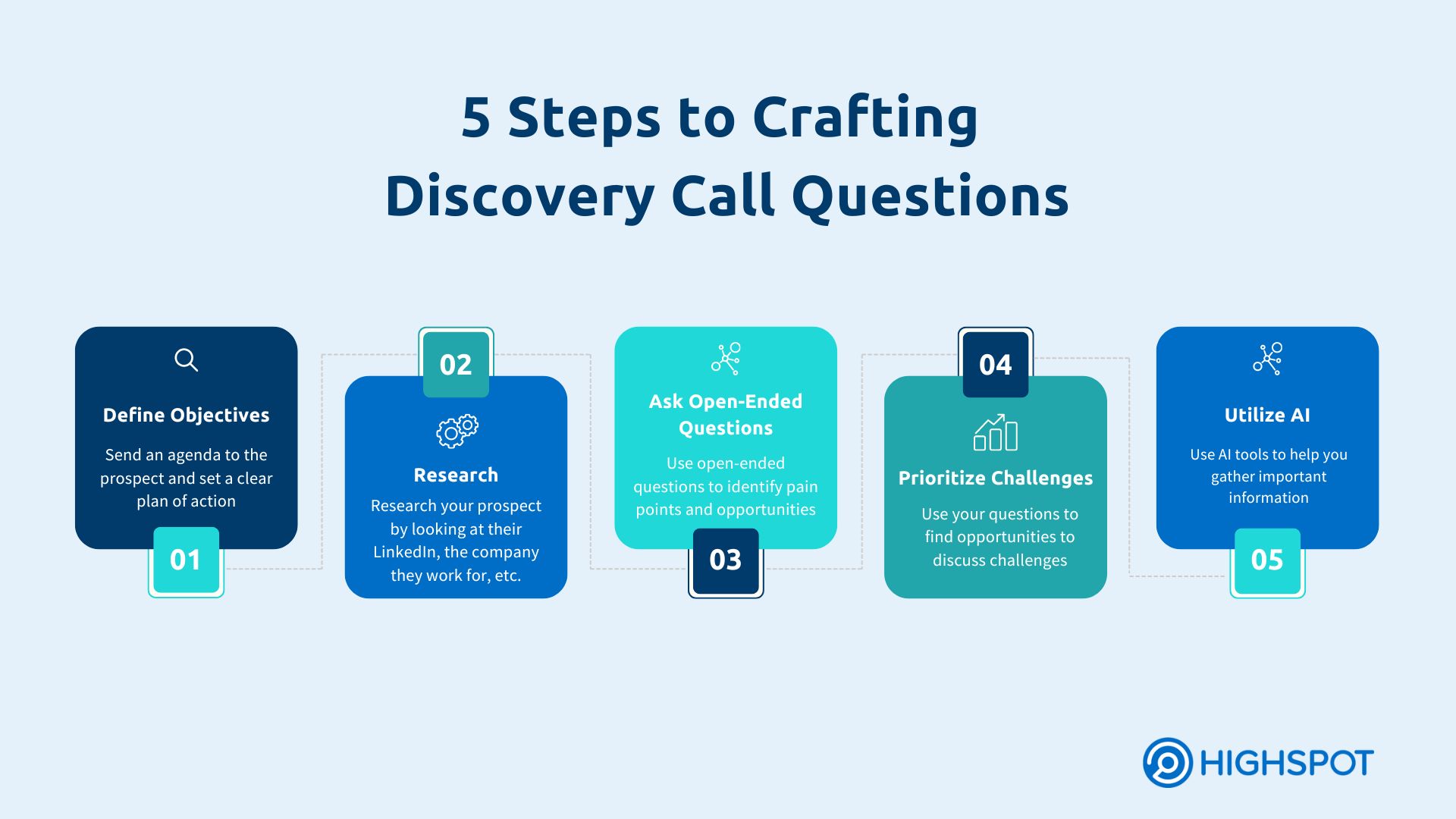Discovery call questions make or break a deal. As a sales rep, this is your opportunity to build a relationship with the buyer and make a good first impression.
The good thing is, your buyer has already expressed interest in the product, all you have to do is identify if they’re a good fit. Easy, right?
Not so much. Nearly half of your buyers will not convert. So how do you ensure that your conversation is meaningful, productive, and ultimately moves them down the funnel?
It requires asking the right questions that not only qualify the buyer but ensure that your product can solve their problems in a way that meets their specific requirements.
Good news is, you’re in the right place. This guide will give you tried and tested discovery call questions that not only qualify buyers, but help you build a relationship and focus your time on the deals that drive revenue growth. And what rep doesn’t love that? Let’s begin!
What is a Discovery Call?
A discovery call is the initial discussion between a sales rep and a prospect. The goal is to understand their needs, if they’re a good fit, and whether there’s a relationship worth continuing. To simplify the process, sales reps often use standardised questions that follow the SPIN methodology. This approach focuses on problem-solving and has been shown to increase conversion rates by nearly 17%.
Related: A Strategic Guide to Nailing Your Next Discovery Call
How to Craft the Most Effective Sales Discovery Call Questions

Every question, response, and reaction means something, no matter which persona you’re interacting with. Be prepared, patient, and make sure each question is intentional. To do that, use these five strategies to assemble your questions and set yourself up for success.
- Define the objectives: Before the call, define what you need to understand about the prospect’s situation. Send a detailed agenda beforehand to align on what needs to be discussed. The goal here is to identify what topics the buyer wants to go through. Keep in mind that this call was triggered by an action the buyer took. Steer the conversation towards what you know and then begin diving into other topics once you feel there’s a relationship worth fostering.
- Research your prospect: Investigate your prospect’s business and industry on LinkedIn, company press releases, financial statements, and market research tools. It’s been noted that 42% of sales reps feel they don’t have enough information before making a call, so it’s important that you use what’s available. You can predetermine if there’s a fit between their business and what your product or service offers. If there isn’t a fit, you can qualify out early in the discovery process, saving time for everyone.
- Focus on open-ended questions: Craft questions that dig into the prospect’s biggest challenges, allowing you to showcase compelling value without overwhelming them with features or compromising time. Focusing on the prospect and not your product makes your value proposition relevant.
- Prioritise prospect challenges: Direct your questions towards uncovering the specific obstacles. You can show how your solution addresses their needs by referencing their pain points.
- Utilise AI: AI tools can analyse vast amounts of data from various sources such as social media, company websites, and public records to give a background before your first call. This will help you tailor discovery call questions without extensive manual research.
Three Types of Sales Discovery Call Questions
Customer dynamics, relationships, and individual personalities influence discovery calls. No single question type fits all scenarios, so tailor your conversation to what you know about your prospect. Nearly 47% of buyers will have interacted with your site 3-5 times, so use this information to your advantage. Here’s a breakdown of three types of questions to keep the conversation interactive.
- Open-ended questions: Instead of asking, “Do you struggle with enabling your sales team?” (which gets a simple yes or no), try something like, “Can you tell me about your experience enabling your sales team?” This encourages your potential customers to share valuable details that can shape your approach.
- Close-ended questions: While open-ended questions invite exploration, close-ended ones offer clarity. For instance, instead of asking, “What challenges are you facing?” (which could lead to a lengthy response), you might ask, “When speaking with other leaders in your space, I hear these problems. Do any of those sound familiar to you?” This prompts a straightforward answer, guiding your conversation.
- Probing questions: Probing questions dive deeper into specific areas of interest. For example, after learning about a challenge, you might ask, “When problems like this exist, it often impacts many business areas. Can you elaborate on how this affects your team’s performance?” This uncovers additional details that can inform your next steps.
Top 18 Questions to Ask During Your Discovery Call
Asking the right questions during a discovery call helps guide the buying process and filter opportunities early. Each question should serve a purpose: to understand the company better, qualify the prospect’s needs, identify potential roadblocks, and set the stage for follow-up actions.
Here’s a further breakdown of the questions to help you uncover a legitimate problem and build trust.
Open-Ended Questions that Kick Things Off
Use open-ended questions to get the prospect talking. While closed-ended questions have their place, open-ended questions will set the stage for a valuable conversation. Start by asking about the prospect’s role and the company. This lets them describe their business in their own words. Flow into a conversation from there.
Question #1: Tell Me About your Role
Understanding the prospect’s role provides visibility into their day-to-day duties and decision-making process. This information is vital for tailoring your sales pitch and knowing how your solution can make their job easier.
Question #2: What Do You Like About Your Current Process?
This question attempts to get to the root of what works and what doesn’t. Is it a process, people, or supporting tool problem? This helps the salesperson identify strengths in the current approach and tailor further questions to complement or improve the working or broken process.
Question #3: What’s Stopping You from Achieving Your Goals?
Identify internal barriers that hinder the prospect’s progress. It could be a lack of leadership buy-in, budget constraints, or unidentified root problems.
Question #4: What’s Your Ideal Solution?
By asking the prospect specific questions about their ideal solution, the sales rep will learn preferences, priorities, and levels of expectations. This will help you tailor your sales pitch to recommend the best solution later on.
Best Qualifying Questions To Determine If There’s a Fit
The key to qualifying questions in the sales discovery process is to listen actively and encourage more sharing. If possible, suggest screen sharing to facilitate more details of the problem.
Question #5: Tell Me About Your Goals
This question will help reveal the prospect’s short-term and long-term objectives. Knowing their goals enables you to position your product or service. When the solution helps them achieve their goals, it will be more relevant and appealing.
Question #6: What Problem Are You Trying to Solve?
Identifying the prospect’s specific challenges allows you to position your product as THE solution. This question will help establish your product’s value and uncover the urgency of finding a solution.
Question #7: What Is Happening In Your Business Now That Has Led You To Solve This Problem?
Learn more about the broader business happenings during this first call. This question will uncover events that have triggered the need to address the problem. You may discover the issue’s urgency, relevance, and impact on the potential client’s business operations.
Question #8: What Would a Successful Outcome Look Like?
Asking this question helps you understand the prospect’s expectations and what success means to them. It allows you to gauge whether your solution can meet these expectations and provides a benchmark for proving your product’s value.
Question #9: What’s Stopping You From Relying On Your Existing Solutions And Processes To Address The Problem?
This question aims to understand why the prospect is considering alternatives to their current solutions or processes. It helps identify dissatisfaction with existing methods and provides insights into the prospect’s openness to change.
Top Disqualifying Question to Save Time
These questions safeguard sales rep time by assessing if the problem is significant enough, its priority, if implementation is soon, and potential barriers. Sometimes, a prospect may not hold decision-maker authority or view the issue as a top priority. Asking these questions early on will help you protect your time.
Question #10: Is this a Problem You Can Live With?
Knowing if the problem is big enough to solve is essential for effective discovery. Is it blocking a priority or business goal, or is a solution simply a nice to have?
Question #11: What Are Your Roadblocks?
This question helps identify any obstacles preventing the prospect from purchasing your product. Understanding these barriers early on can save time by focusing on prospects more likely to convert.
Question #12: What’s Your Budget?
Knowing the prospect’s budget helps determine if they can afford your solution. This question is crucial for qualifying the financial feasibility of the sales opportunity.
Question #13: What’s Your Timeline for Implementation?
The timeline question helps assess the urgency of the prospect’s need. It also allows you to understand decision-maker readiness to move forward and can influence how you prioritise this prospect in your sales process.
Follow-Up Questions That Establish the Next Steps
Never end a meeting without understanding past experiences, current situation, future expectations, consequences of inaction, identifying stakeholders, a recap, and offering to facilitate the next steps. Discuss calendars and schedule follow-up interactions before the call is over. Your sales leaders will thank you.
Question #14: Have You Purchased a Similar Product Before?
This question provides valuable insights into the prospect’s experiences and satisfaction with other solutions. It can reveal their expectations and any hesitations based on past disappointments. You can also leverage your competitive knowledge once you know the products you’re competing against.
Question #15: What Improvements Do You Anticipate a Year After Implementation?
Asking this question will help you explore a ‘what if.’ You’ll have the opportunity to gauge whether their vision is practical. Understanding the prospect’s vision for the future with your solution can help you tailor your follow-up and ensure that your product aligns with their future plans. It may even disqualify them as prospects if you cannot achieve their ideals.
Question #16: What Happens if You Don’t Solve This Problem in the Next Three Months?
How serious is their problem? Are the consequences dire to the business? Asking about the outcomes of not achieving their goals highlights the importance of the problem and can elevate the urgency of finding a new solution. This can potentially accelerate the purchasing process.
Question #17: Who Else has a Vested Interest in Solving the Problem?
Knowing all stakeholders and influencers involved in decision-making helps you understand the complex buying team dynamics. Gartner states, “The average enterprise B2B buying group consists of five to 11 stakeholders, representing an average of five distinct business functions.” Who else do you need to convince?
Question #18: How Can I Help Make This Easy?
This question demonstrates your commitment to facilitating a smooth customer experience. It also shows you are proactive in overcoming potential obstacles that could complicate the deal.
Following the discovery call, you can utilise AI tools to analyse the conversation via transcription. This will guide follow-up actions and further personalise the sales approach.
How Many Questions Should You Ask During a Discovery Call?
In the brief span of a discovery call, you must strike the right balance—avoiding interrogation and ensuring the conversation flows naturally. With calls typically lasting around 15-30 minutes, every question must carry weight, making each moment count. Experts say that the ideal number of questions to ask is between 11-14, so keep that in mind as you craft your agenda.
- Read the room: Pay attention to the prospect’s demeanour, tone, and responses to gauge their engagement and adjust your communication.
- Respect time: Be mindful of the allotted time for the call and prioritise the most relevant and impactful questions within that timeframe.
- Focus only on essentials: Cut through the clutter by asking questions directly addressing the prospect’s key challenges, goals, and decision-making criteria.
- Listen before you speak: Practise soft sales skills like active listening to fully understand the prospect’s responses before formulating your next question or response.
- Prioritise quality over quantity: Instead of overwhelming the prospect with a barrage of questions, focus on asking thoughtful, high-quality questions.
Make the Most of Discovery Calls with Highspot
Taking the time to truly understand your prospect helps build rapport and significantly boosts your chances of advancing the buyer’s journey and closing deals. Make every conversation count with Highspot’s advanced tools, designed to support you in hosting great discovery calls. Sales playbooks, complex analytics, conversational intelligence, and support for in-the-moment and ongoing training and coaching help transform discovery calls into a successful sales strategy tool.
Request a Highspot product demo today.




